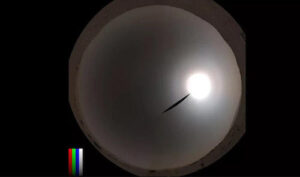SEPTEMBER 17, 2022

When it comes to space science, there is still a whole world out there we know very little about. Even some of the floating rocks up there that have been studied for a while, like Mars, astronomers are still learning more about, and their findings continue to shock us all. Now, the latest Mars discovery proves a theory scientists have held for a while, but never thought they’d actually see. Here’s what you need to know.
According to Space.com, NASA’s Perseverance rover, which is currently hanging out on Mars, was able to capture a moment of perfect conditions, proving a theory astronomers have held for a long while: The rover captured a sun halo.

“On Earth, when conditions are just right, ice crystals in the atmosphere can warp sunlight to create the appearance of a bright spot on either side of the sun, or of a halo ringing it,” Space.com explains. Astronomers long believed that the optical phenomenon could happen on other plants. But in a decade of exploring, this was never captured.
That changed on December 15, 2021, when Perseverance was able to capture the phenomenon.
“Perseverance really surprised us with some of the images that we got back in December,” Mark Lemmon, a planetary scientist at the Space Science Institute, a nonprofit research institute in Boulder, told Space.com.
“I’ve been involved with this for a long time, and we’ve looked for halos everywhere and in lots of images,” he added. “I looked at that and I thought, ‘I’m gonna have a hard time finding an explanation for this.’ Because everything has been a false alarm, and that just looks so much like a halo that I thought it was going to be a lot of work to figure out what was really going on.”
Space.com explains that when the conditions are just right, we can see the halo phenomenon here on Earth. It happens when ice crystals in the atmosphere bend sunlight to create an appearance of a bright spot or a halo around the sun.
The size and temperature of the crystals impact whether or not a halo can be seen. Also, crystals consisting of other chemicals in the atmosphere can produce a halo, but they’ll look slightly different than what we see on Earth, Space.com explains.
“It’s almost like a fingerprint that tells you what the element was, what the shape of the particle was, and then a little bit about the size,” Lemmon said.
Capturing the halo on Mars was a big moment for the researchers, who published their findings in the Sept. 3 issue of Geophysical Research Letters. Lemmon explained that seeing the halo was incredible and will teach them a lot. But in typical science fashion, he wants to replicate the findings before he gets too excited.
“I think the most important thing for us is that we’ve learned that it is a thing that can happen,” he said. “We need to look harder for it at Perseverance, at that site.”

































































































